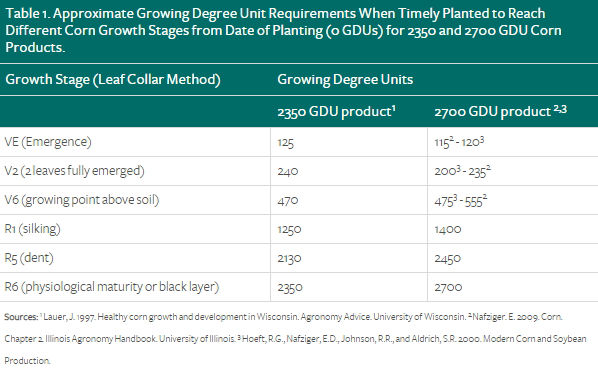6 MIN READ
Maturation Comparison of Early and Mid-Season Corn Products
September 11, 2018
Key Points
- Kernel black layer seals the kernel from further test weight gain.
- Product relative maturity and environmental issues can influence the timing of black layer formation.
- Kernel milk line can be used as a measure of kernel moisture content as the kernel advances toward black layer.
- Kernel moisture content is lost faster with warm, dry weather and slower with wet, cool weather.
What is Black Layer or Physiological Maturity
Reproductive Corn Growth Stages

Field Drydown
Product Characteristics Impacting Drydown
Aside from product RM and environment, individual product characteristics can influence the speed of kernel moisture content loss. Characteristics that influence the rate of kernel drydown include:
- Thickness and Number of Husk Leaves. Thinner and fewer husk leaves can promote quicker moisture content loss.
- Husk Death. Quicker death of husk leaves promotes quicker moisture content loss.
- Ear Tip Exposure. Exposed ear tips may provide for quicker kernel moisture content loss.
- Husk Tightness. Husks that are loose and open may help increase grain drying.
- Ear Angle. Drooping ears tend to lose moisture content more quickly. Upright ears can capture moisture from rainfall.
- Kernel Pericarp Properties. Thinner pericarps (outer layer covering a corn kernel) have been associated with faster moisture content loss.
Maturity Calculators
Corn maturity calculators are available online from universities and other sources. By entering a location, planting date, and the GDU to silk or black layer, a maturity date can be estimated. Online sites include:
- The University of Wisconsin offers a calculator for Android mobile devices: http://ipcm.wisc.edu/blog/2015/02/5-free-apps-for-wisconsin-crop-production/
- South Dakota State University offers a web-based calculator: http://climate.sdstate.edu/awdn/archive/de greedays.asp
- Michigan State University offers weather-based pest, natural resource and production management tools online at: http://enviroweather.msu.edu.
- Illinois State Water Survey offers a web-based calculator: www.isws.illinois.edu/warm/cropdata/cro pddcalc.asp
- University of Missouri Corn Maturity Calculator: http://plantsci.missouri.edu/grains /corn/calculator/index.cfm
Sources
Once corn planting is delayed, the yield potential of the crop varies with the rest of the growing season. Insect pressure, especially from late generations of European corn borer, corn ear worm, and fall armyworm, can significantly damage a late-planted corn crop. Planting a B.t. corn product can greatly reduce this risk.3 Plant population should reflect the yield expectation and it is important to be very timely with fertilizer applications and weed control as a late-planted corn crop will accumulate heat units faster than an earlier-planted corn crop.
Delayed corn planting may also increase the chance of heat and drought stress during the critical water use periods (two weeks prior to silking and during pollination). Planting corn products that range in GDU requirements for flowering and physiological maturity can help reduce the chance that the whole corn crop flowers during a period of high heat or is damaged by frost later in the season (Figure 2).
1 Nielsen, R.L. 2013. Grain fill stages in corn. Corny News Network Articles. Purdue University. https://www.agry.purdue.edu/ext/corn/news/timeless/GrainFill.html.
2 Nielsen, R.L. 2013. Field drydown of mature corn grain. Corny News Network Articles. Purdue University. https://www.agry.purdue.edu/ext/corn/news/timeless/GrainDying.html.
3 2014. Corn development. Corn Agronomy. University of Wisconsin. www.corn.agronomy.wisc.edu/management/L011.aspx.
4 Corn growth stages with estimated calendar days and growing-degree units. South Dakota State University. https://www.sdstate.edu.
5 Nielsen, B. 2001. Post-maturity grain drydown in the field. Agronomy Tips. Pest & Crop. No. 24. Purdue University. http://extension.entm.purdue.edu.
6 Lauer, J. 1997. Healthy corn growth and development in Wisconsin. Agronomy Advice. University of Wisconsin.
7 Nafziger. E. 2009. Corn. Chapter 2. Illinois Agronomy Handbook. University of Illinois.
8 Hoeft, R.G., Nafziger, E.D., Johnson, R.R., and Aldrich, S.R. 2000. Modern Corn and Soybean Production. Additional source: Geyer, A. and Thomison, P. Corn drydown. C.O.R.N. Newsletter 2006-28. The Ohio State University.
Web sources verified 8/1/2016. 130905070122
